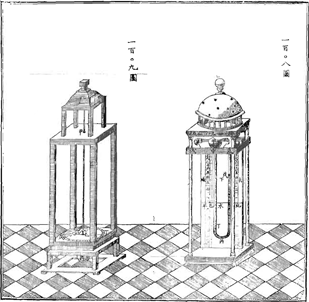Everything Important is Countable in China
Seven Sages
The Seven Sages of the Bamboo Grove were a group of Chinese Taoist Qingtan scholars, writers, and musicians who came together in the 3rd century CE. They are depicted in dozens of important paintings and became symbols of high culture for the remainder of the imperial age.By Qingtan scholars, I mean that these men engaged in witty back-and-forth about metaphysics and philosophy. The Seven Sages stressed the enjoyment of ale, personal freedom, spontaneity and a celebration of nature.
These men of intellect were exasperated with the intrigues, corruption and rigidity of court life during the politically fraught Three Kingdoms period of Chinese history. They gathered near the home Xi Kang (also and usually, Ji Kang), perhaps their most illustrious member. Xi Kang was highly critical of Confucianism and challenged many social conventions of his time. As such, he was considered scandalous and seditious. Three thousand university students signed a petition to release him after he was sentenced to death by Sima Zhao, but the appeal was denied. Before his execution, Xi Kang asked for his zither and played his swan song, the famous guqin masterpiece Guangling san, which music is presumed to be forever lost.
 |
| The Seven Sages of the Bamboo Grove (with boy attendant), in a Kano school Japanese painting of the Edo period |
Six Arts
The Six Arts formed the basis of education in ancient Chinese culture. During the Zhou Dynasty (1122–256 BCE), students were required to master the "liù yì" (六藝) (Six Arts):- Rites (禮)
- Music (樂)
- Archery (射)
- Charioteering (禦)
- Calligraphy (書)
- Mathematics (數)
 |
| Zhou Tong teaching Yue Fei archery. |
The Six Arts grew out of the Confucian philosophy. As such, Xu Gan (170–217 CE) discusses them in the Balanced Discourses. Eventually they evolved to just four arts. Math was replaced by the Game of Go or weiqi, about which quite a bit has been written on these pages. Music was limited to the playing of a specific traditional Chinese instrument, the qin. Calligraphy was retained and painting was added. Manners or etiquette ("rites") went the way of chivalry in the West and mastery of the outmoded transport (chariot) and weaponry (bow and arrow) was abandoned.
Five Punishments
A Wikipedia entry tells us that The Five Punishments in Ancient China evolved into The Five Punishments in Imperial China and that there were also The Five Punishments for female offenders. The “Five Punishments for Slaves” were abolished during the reign of Emperor Wen of Han following a petition from a female subject Chunyu Tiying (淳于缇萦), and replaced by the “Five Punishments for Serfs”.These are the ancient ones:
- Mò (墨), also known as qíng (黥), where the offender would be tattooed on the face or forehead with indelible ink. (1,000 crimes)
- Yì (劓), where the offender's nose was cut off. (1,000 crimes)
- Yuè (刖), also known as bìn (膑/臏) during the Xia Dynasty and zhǎnzhǐ (斩趾) during the Qin Dynasty, involved amputation of the left or right foot or both. Other sources claim that this punishment involved removal of the kneecap, which is claimed to be the source of Warring States Period military strategist Sun Bin’s name. (500 crimes)
- Gōng (宫), also known as yínxíng (淫刑), fǔxíng (腐刑)[7][8] or cánshì xíng (蚕室刑), where the male offender’s reproductive organs were removed.[9][10] The penis was removed and testicles were cut off, and the offender was sentenced to work as a eunuch in the Imperial palace.[11][12] Gōng for men was applied to the same crime as gōng for women, namely adultery, "licentious" or "promiscuous" activity.[13] (300 crimes)
- Dà Pì (大辟), the death sentence. Methods of execution were quartering, or cutting the body into four pieces (fēn wéi lù 分为戮); boiling alive (pēng 烹); tearing off an offender's head and four limbs by attaching them to chariots (chēliè 车裂); beheading (xiāoshǒu 枭首); execution then abandonment of the offender’s body in the local public market (qìshì 弃市); strangulation (jiǎo 绞); and slow slicing (língchí 凌迟). Other methods of execution were also used. (200 crimes)
The Four Classic Novels
Not be confused with the Four Books and Five Classics, the Four Classic novels are:| English | Simplified Chinese | Author | Date |
|---|---|---|---|
| Water Margin | 水浒传 | Shi Nai'an[2] | 14th century |
| Romance of the Three Kingdoms | 三国演义 | Luo Guanzhong | 14th century |
| Journey to the West | 西游记 | Wu Cheng'en | 16th century |
| Dream of the Red Chamber | 红楼梦 | Cao Xueqin | 18th century |
I have not read Water Margin, alternatively called Outlaws of the Swamp, nor have I cracked the Romance of the Three Kingdoms.
I am currently mired in The Dream of Red Mansions, variously called Dream of the Red Chamber. It competes with Tolstoy in terms of the introduction of a large number of different characters. It dwarfs War and Peace with its 120 chapters. I will not participate in the absurd reductionism that would be required to offer a synopsis of the story, but rather simply recommend it to one and all. It is widely read here and there are questions on the national college entrance examination that require recitation of the characters. It is filled with elegant, masterful poetry that in my translation is still superlatively elegant.
Finally, a fifth book bears mention, The Plum in the Golden Vase. It is banned in China as a piece of pornography, but is recognized by the Princeton University Press as "a landmark in the development of the narrative art form – not only from a specifically Chinese perspective but in a world-historical context...noted for its surprisingly modern technique" and "with the possible exception of The Tale of Genji (ca. 1010) and Don Quixote (1605, 1615), there is no earlier work of prose fiction of equal sophistication in world literature."
_______________
Most of this information has been lifted from the font of all knowledge (Wikipedia) and carefully picked-over by yours truly. There are some segments that I have not even bothered to re-write. It is












